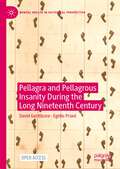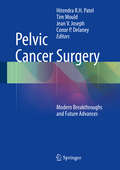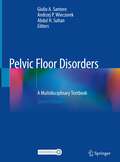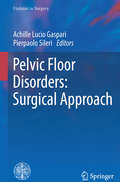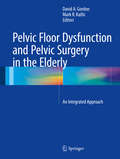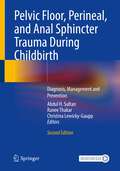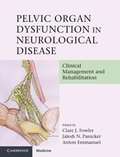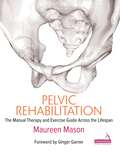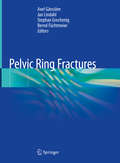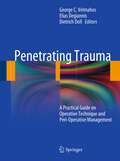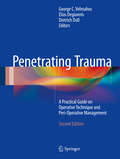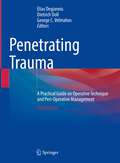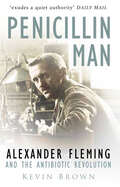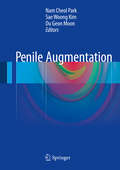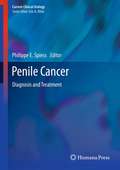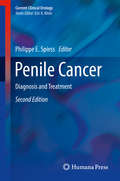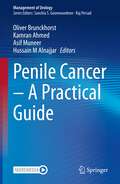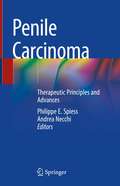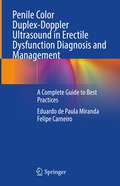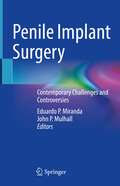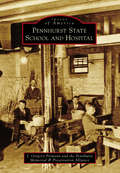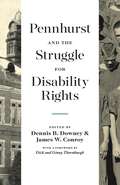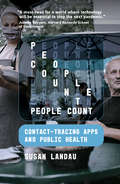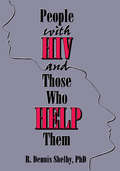- Table View
- List View
Pellagra and Pellagrous Insanity During the Long Nineteenth Century (Mental Health in Historical Perspective)
by David Gentilcore Egidio PrianiThis open access book explores the history of pellagra, a vitamin deficiency disease brought about by a shift in agriculture to maize, and which was first identified in Italy in the 1760s. With a focus on the insanity that was caused by the disease, the authors examine how thousands of patients were treated in Italian psychiatric asylums, shedding light on the sufferer’s point of view. Setting pellagrous insanity in a wider context of man-made or societal (anthropogenic) disease, where poverty, diet and disease meet, the book contributes to the history of medicine and science, the history of psychiatry, economic and social history, agrarian history, and food and nutrition history. Additionally, the authors aim to transnationalise Italian history by making comparisons with related issues, such as tertiary syphilis in the UK. Drawing from a wide range of printed and archival sources, including the writings of Italian medical investigators, the book examines how medical and scientific research was carried out during the long nineteenth century and the uncertainties that this engendered, in terms of classification, explanation, diagnosis and treatment. Offering a unique perspective on an endemic illness which came to be known as the disease of the four ds: dermatitis; diarrhea; dementia; and death, this book provides an engaging account of one of the most perplexing causes of mental illness.
Pelvic Cancer Surgery
by Hitendra R.H. Patel Jean V. Joseph Conor P. Delaney Tim MouldPelvic Cancer Surgery: Modern Breakthroughs and Future Advances brings together the three main pelvic specialties (Urology, Gynecological Oncology and Colorectal Surgery) into one volume. Patients have been shown to benefit from a multidisciplinary approach since it allows surgeons of different specialties to learn from one another therefore enhancing the treatment for the patient. Pelvic cancer outcomes are poor in low volume centres. These centres account for 80% of the global centres dealing with these cancers. Pelvic Cancer Surgery: Modern Breakthroughs and Future Advances is a much needed book that can focus training and assist health professionals in their care of patients with pelvic dysfunction. Pelvic Cancer Surgery: Modern Breakthroughs and Future Advance is complete with full color illustrations and schematic diagrams and makes use of key points and stepwise figures for an enhanced learning experience.
Pelvic Floor Disorders: A Multidisciplinary Textbook
by Giulio A. Santoro Andrzej P. Wieczorek Abdul H. SultanThis excellent textbook provides up-to-date information on all aspects of pelvic floor disorders. After an opening section on anatomy and physiology, it explains the methodology, role and application of the integrated imaging approach in detail, including the most advanced 3D, 4D, and dynamic ultrasound techniques, illustrated with hundreds of images. It then discusses in depth the epidemiology, etiology, assessment, and management of the full range of pelvic floor disorders from multidisciplinary and practical perspectives. The book also provides information on the various forms of obstetric perineal trauma, urinary incontinence and voiding dysfunction, anal incontinence, pelvic organ prolapse, constipation and obstructed defecation, pelvic pain and sexual dysfunction, and fistulas, and includes treatment algorithms as well as helpful guidance on what to do when surgical treatment goes wrong. The authors are leading experts in the field from around the globe. Since the first edition from 2010 (more than 200,000 chapter downloads), the book has been extensively rewritten and features numerous additional topics. The result is a comprehensive textbook that is invaluable for gynecologists, colorectal surgeons, urologists, radiologists, and gastroenterologists, beginners and veterans alike.
Pelvic Floor Disorders: Surgical Approach
by Achille Lucio Gaspari Pierpaolo SileriDuring recent decades, more than 100 surgical procedures have been proposed to treat pelvic organ prolapse, and surgeons are still searching for the ideal approach. Although generally accepted guidelines and algorithms are still lacking, careful preoperative work-up and patient selection can serve as a sound basis for tailored surgery. In this comprehensive book, leading experts from around the world provide a detailed, up-to-date overview of the diagnostic and surgical approaches employed in patients with prolapse of the middle or posterior pelvic floor compartment. Each surgical technique is explained step by step with the aid of instructive figures. Guidance is also included on the management of surgical complications and of recurrent disease - aspects that are too frequently overlooked in the scientific literature. This book will prove essential reading for all who are interested in functional colorectal disorders of the pelvic floor and will represent a unique and invaluable source of knowledge for general surgeons, colorectal surgeons, and urogynecologists, whether in training or practice.
Pelvic Floor Dysfunction and Pelvic Surgery in the Elderly
by Mark R. Katlic David A. GordonThis text provides a comprehensive, state of the art review of this field and will serve as a resource for urologists, colorectal surgeons, geriatricians, and gynecologists as well as researchers interested in neuromuscular phenomena in the pelvis. The book also reviews new data regarding risk factors for pelvic floor muscle dysfunction and profiles new minimally invasive surgical strategies for well known pelvic disease processes. Each chapter is chock full of data from landmark trials which have been published over the past few years and placed in context with respect to current management techniques for pelvic floor disorders. Written by experts in their field, Pelvic Floor Dysfunction and Pelvic Surgery in the Elderly: An Integrated Approach provides a concise yet comprehensive summary to help guide patient management.
Pelvic Floor, Perineal, and Anal Sphincter Trauma During Childbirth: Diagnosis, Management and Prevention
by Ranee Thakar Abdul H. Sultan Christina Lewicky-GauppPelvic Floor, Perineal, and Anal Sphincter Trauma During Childbirth is a comprehensive text that focuses on the maternal morbidity associated with childbirth. The book is edited by a reputable international team of obstetricians and urogynaecologists who have an in-depth knowledge of the subject and are actively involved in training and research. In recognition of the longstanding global diversity in obstetric practice and the management of its sequelae, the authors have compiled the ultimate evidence-based textbook that examines the diagnosis, pathophysiology, management, and prevention of obstetric trauma. It is known that the majority of doctors and midwives have suboptimal training in the anatomy and repair of perineal and anal sphincter trauma. This book aims to address these deficiencies by providing a comprehensive approach in the understanding of this anatomy and provides tips on making an accurate diagnosis and classification of perineal trauma. The dilemmas surrounding repair techniques and management of subsequent pregnancies are fully debated and preventative strategies are highlighted. Chapters on female genital mutilation, the management of faecal incontinence, caesarean section, pre-existing bowel conditions, sexual dysfunction and litigation are also Included. This book is essential reading for all who are involved in obstetric care both in the labour ward and even years after parturition; obstetricians, midwives, family practitioners, colorectal surgeons, gastroenterologists, physiotherapists, continence advisors and lawyers can all glean knowledge applicable to their own specialty. In everyday practice, the text can also serve as a handbook for quick reference and should therefore be easily accessible in all antenatal clinics labour ward rooms and perineal/pelvic floor clinics.
Pelvic Organ Dysfunction in Neurological Disease
by Jalesh N. Panicker Clare J. Fowler Anton EmmanuelPelvic Organ Dysfunction in Neurological Disease describes the neurological control of human bladder, bowel and sexual function and then details the dysfunctions which may arise as a consequence of various neurological diseases. Easy to read, the book will be of value to any healthcare professional managing patients in whom pelvic organ functions have been compromised by neurological disease. The book provides a structured approach to present day understanding of the neurological control of pelvic organs and the investigation and management of each type of organ dysfunction. A unique feature of this book is that it addresses the impact of specific neurological disorders on all three functions. The authors have all been associated with the Department of Uro-Neurology at the National Hospital for Neurology and Neurosurgery, London since it was established 20 years ago. This book is a timely review of their accumulated knowledge and the latest literature.
Pelvic Rehabilitation: The Manual Therapy and Exercise Guide across the Lifespan
by Maureen MasonThis book presents paradigms and programs for pelvic health conditions over the lifespan from childhood to senior years, with medical pearls and storytelling. It includes new concepts and practices with the integration of Medical Therapeutic Yoga and Pilates into rehabilitation prescriptions, sexual medicine, and strategies for healing pain and trauma.The contributors have a wealth of clinical experience, from pediatrics to geriatrics, and the client care focus is with manual therapy, exercise, education, and compassion based treatment. Physical therapy, Yoga and Pilates are woven together to provide evidence based platforms for health care intervention for pelvic pain, bladder and bowel dysfunction, pelvic organ prolapse, sexual medicine, and trauma sensitive care. Medical professionals as well as body workers, fitness trainers and community educators can glean critical health care knowledge as well as strategies for teamwork for client care. Health conditions pertaining to the pelvis are often under recognized, disregarded by most medical practitioners, and suffered in silence, humiliation and shame by most clients. The text will support global health care education and empowerment regarding pelvic health conditions and conservative care options. The text is integrative in considering the biopsychosocial model as well as current medical standards in pelvic rehabilitation treatment, as well as health promotion with nutrition and supplements.
Pelvic Ring Fractures
by Axel Gänsslen Jan Lindahl Stephan Grechenig Bernd FüchtmeierThis book provides in-depth coverage of all aspects of pelvic ring fractures and their management. The opening chapters supply essential information on surgical anatomy, biomechanics, classification, clinical evaluation, radiological diagnostics, and emergency and acute management. The various operative techniques, including navigation techniques, that have been established and standardized over the past two decades are then presented in a step-by-step approach. Readers will find guidance on surgical indications, choice of approaches, reduction and fixation strategies, complication management, and optimization of long-term results. Specific treatment concepts are described for age-specific fractures, including pediatric and geriatric injuries, and secondary reconstructions. Pelvic ring fractures represent challenging injuries, especially when they present with concomitant hemodynamic instability. This book will help trauma and orthopaedic surgeons at all levels of experience to achieve the primary treatment aim of anatomic restoration of the bony pelvis to preserve biomechanical stability and avoid malunion with resulting clinical impairments.
Penetrating Trauma
by Dietrich Doll Elias Degiannis George C. VelmahosSurgery needs skill. Skill needs knowledge. Knowledge of tricks, moves, and tools. This book is about such knowledge. Expert authors have contributed technical pearls, gained by years of experience. The short "how-I-do-it" chapters offer the reader a quick and effective guide that will be invaluable when addressing any penetrating injury. The book is not intended to serve as a comprehensive volume of pathophysiology and management in trauma; rather the goal is to provide practical solutions on how to treat injuries surgically. It describes the steps that you must take when, in the middle of the night, confronted with devastating bleeding, you will have only one chance to save a life!
Penetrating Trauma
by Dietrich Doll Elias Degiannis George C. VelmahosThis book provides clear practical guidance on all aspects of the surgical treatment of penetrating trauma and aims to foster the type of strategic thinking that can save patients' lives. The coverage encompasses prehospital care, penetrating injuries to various body regions and specific organs, orthopedic injuries, peripheral arterial injuries, injuries to special groups of patients, including children and the elderly, military injuries, and a range of other topics. Based on their extensive personal experience, expert authors provide step-by-step instructions on evaluation, surgical techniques, and management of perioperative problems. Tips and tricks and technical pearls are highlighted and each chapter includes a list of the most important points to observe. This second edition of Penetrating Trauma has been extensively revised and updated - with inclusion of some entirely new chapters - to take into account the most recent trends in resuscitation, diagnostics, and treatment. It will be an ideal resource for those looking for practical solutions on how to treat injuries surgically.
Penetrating Trauma: A Practical Guide on Operative Technique and Peri-Operative Management
by Dietrich Doll Elias Degiannis George C. VelmahosThis is the third, fully revised edition of a well received book that provides clear practical guidance on all aspects of the penetrating trauma surgical treatment. It aims at fostering the type of strategic thinking that can save patients’ lives. The coverage encompasses prehospital care and operative management in penetrating injuries to various body regions and specific organs. Tips, tricks and technical pearls are highlighted by experienced doctors and each chapter includes a list of the most important points to observe. This third edition of Penetrating Trauma has been extensively revised and updated – with inclusion of some entirely new chapters – to take into account the most recent trends in resuscitation, diagnostics, and treatment. It will be an ideal resource for all physicians managing penetrating trauma.
Penicillin Man: Alexander Fleming and the Antibiotic Revolution
by Kevin BrownPenicillin revolutionized healthcare and turned the modest, self-effacing Alexander Fleming into a world hero. This book tells the story of the man and his discovery set against a background of the transformation of medical research from 19th-century individualism through to teamwork and modern-day international big business.
Penile Augmentation
by Nam Cheol Park Sae Woong Kim Du Geon MoonThis book presents state of the art knowledge on penile augmentation with a view to providing a guide that will be highly relevant to clinical practice. The coverage is wide ranging, with clear descriptions of penile anatomy, patient selection and counselling, preoperative preparation, girth enhancement and penile lengthening techniques, postoperative care, and the approach to the pediatric patient. Experienced surgeons describe operative procedures from traditional fat transfer to the penile disassembly technique and reconstruction of the amputated penis, while the newest tissue engineering techniques are presented by leading researchers with reference to high-quality data. In addition, the role of auxiliary medical devices is explained. The text is supported by numerous full-color illustrations. Only recently have the requisite medical skills and techniques been developed to allow safe and reliable penile augmentation, and now the procedure is considered comparable to the use of mammoplasty for breast augmentation in women for cosmetic and psychological reasons. Penile Augmentation will be of value for all who are involved or interested in the procedure.
Penile Cancer
by Philippe E. SpiessPenile Cancer: Diagnosis and Management provides a comprehensive overview of penile cancer for medical and surgical urologists oncologists, and other healthcare professionals. This book highlights many of the significant advances made in this field, which include a discussion of penile-sparing surgical and radiotherapeutic approaches to select primary penile tumors typically of lower stage and grade as well as advances in our understanding of the epidemiology, risk factors, and pathophysiology of penile cancer. The book also addresses many of the novel diagnostic and therapeutic surgical approaches to inguinal lymph nodes, including dynamic sentinel node biopsy and minimally invasive surgery. The authors also discuss many of the clinical pearls and surgical considerations that can optimize treatment outcomes while minimizing the morbidity and inherent risk of complications in patients undergoing an open inguinal lymph node dissection. Lastly, the volume presents a discussion of the paradigm shift in the management of bulky inguinal lymph node metastases from penile cancer consisting of neoadjuvant systemic chemotherapy followed by consolidative surgical resection, which can offer an improved likelihood of survival as shown in a recent phase 3 clinical trial. Penile Cancer: Diagnosis and Management will serve as a resource for clinicians and researchers seeking an overview on the current state of knowledge in penile cancer. The editor has gathered leading worldwide experts in this field who have written a very practical and useful textbook for clinicians in an attempt to optimize patient outcomes and promote the pivotal scientific advances made in recent years.
Penile Cancer
by Philippe E. SpiessThis fully updated and revised second edition address specifically some of the significant advances made in our understanding of the pathophysiology of penile cancer including discussion of the suspected role of the human papilloma virus in penile carcinogenesis. Similarly, the molecular pathways implicated in precancerous and penile cancer will be discussed as these are the present targets of novel therapeutic approaches to this disease. The text details the recent national and international diagnostic and treatment guidelines that have been developed by both the National Comprehensive Cancer Network#65533; and the European Urological Association establishing evidence based standards upon which the care of penile cancer should be based. The text also covers significant advances made in the diagnostic and therapeutic approach to both primary tumors and inguinal nodal metastases resulting from penile cancer such as penile sparing surgery and minimally invasive inguinal lymph node surgery. The text will similarly highlights the improvement in cancer specific outcome in the management of loco-regionally advanced (N2/3) penile cancer managed by upfront systemic chemotherapy followed by consolidative surgery in appropriately selected patients based on recent prospective phase II data. It also covers the role of radiotherapy in the management of penile cancer for both primary tumors and/or at sites of regional or distant metastases. Finally, some of the novel systemic approaches being devised in the management of advanced penile cancer along with some upcoming international trials soon to be opened which likely will re-define the present therapeutic approaches to penile cancer are discussed. The Second Edition of Penile Cancer: Diagnosis and Treatment will constitute a comprehensive review of the above mentioned subjects in addition to a few select topics of high clinical relevance, with the readership predominantly consisting of urologists, medical and surgical oncologists, and other healthcare professionals.
Penile Cancer – A Practical Guide (Management of Urology)
by Asif Muneer Kamran Ahmed Oliver Brunckhorst Hussain M AlnajjarThis latest book within the Management of Urology series provides a concise and up to date overview of all aspects of penile cancer care. It is an ideal resource for urological trainees and established clinicians seeking an easy-to-digest summary of the topics covered, particularly for those working towards their final specialist examinations. Each chapter covers topics from the aetiology and molecular biology of the disease, diagnostic work up of patients and the differing surgical or non-surgical management techniques available. Learning objectives and key reading sections are included within every chapter that reinforce key points and facilitate the reader in developing a deeper understanding of the topic.Additional questions via app: Download the Springer Nature Flashcards app for free and use exclusive additional material to test your knowledge.
Penile Carcinoma: Therapeutic Principles and Advances
by Philippe E. Spiess Andrea NecchiThis book provides a comprehensive and state-of the-art approach to caring for penile carcinoma patients and provides foundational information related to the molecular pathways implicated in penile carcinogenesis and progression. Penile carcinoma remains one of the most debilitating and life-altering malignancies to affect men, with significant impacts on quality of life, erectile function/sexual activity, and length of life. This book illuminates recent advances in penile cancer sparing treatment approaches and oncologically appropriate therapeutic options that help to maintain quality of life, sexual function, and intimacy for patients. It also elucidates recent understandings of human papilloma virus (HPV) and non-HPV driven pathways, which are suspected to have distinct treatment responses and prognoses. The book explores the management of inguinal lymph nodes in the setting of penile cancer, which can now be managed with the integration of key surgical principles/techniques including the adoption of minimally invasive surgery. Considering a multidisciplinary treatment approach for patients exhibiting either locally advanced or more widespread metastatic disease, the book introduces novel systemic therapies currently in development. Further, this book raises clinician awareness of the significant psychosocial impact of penile carcinoma on patients and their families. Penile Carcinoma: Therapeutic Principles and Advances provides readers with the necessary knowledge and insight to care for penile cancer patients with the use of truly state-of-the-art diagnostic and therapeutic approaches. Cancer patients and their families will greatly benefit from adoption of these principles and the accessibility of such advances to their personalized care.
Penile Color Duplex-Doppler Ultrasound in Erectile Dysfunction Diagnosis and Management: A Complete Guide to Best Practices
by Eduardo de Miranda Felipe CarneiroPenile Color Duplex-Doppler Ultrasound (PDU) is one of the most important tools available to assess patients with erectile dysfunction (ED), which is a prevalent condition affecting near 50% of men over 50 years of age. Hemodynamic evaluations through PDU have also prognostic value and help choose the best treatment strategy for ED. Although PDU is an objective diagnostic method, the lack of standardized protocols is one of its main limitations and might lead to great variability in performing and interpreting penile hemodynamic studies in both clinical practice and scientific research. These factors have contributed to the fact that PDU is often considered unreliable, as it may lead to mistaken treatment protocols. The aim of the present book is to provide a complete guide to performing an adequate hemodynamic study through PDU with pharmaco-induced erection. It will provide a detailed and illustrative overview of the most common pitfalls for a correct conduction ofthis diagnostic procedure. We will also provide an extensive review of the basic principles in erection physiology and pharmacology, allowing a broader understanding of the implications of PDU in clinical practice. This book will appeal to radiologists and urologists. Its highly informative content will become the ultimate guide not only for fully trained physicians who want to optimize and standardize their procedures, but also for residents and trainees of these specialties. In addition, it will be a useful resource for sexual medicine practitioners, and may reach other specialties and/or healthcare areas such as primary care physicians, gynecologists, psychiatrists and psychologists.
Penile Implant Surgery: Contemporary Challenges and Controversies
by John P. Mulhall Eduardo P. MirandaPenile implants have been an effective treatment for erectile dysfunction (ED) for more than 40 years. However, there is now a growing interest in this treatment option, as the number of procedures is expected to increase in the future. This book offers a reference guide for all those practitioners interested in understanding and/or performing this procedure. It will also benefit those in medical education who want to obtain specialized and high-quality knowledge regarding the complexities involved in penile implant surgery. Although the basic description of penile implant surgery is well documented in the literature, a detailed and comprehensive guide with a special focus on the most challenging and controversial aspects is lacking. The few books available on the topic provide a broad overview of prosthetic surgery in general, mainly discuss basic principles, and fail to provide a more detailed perspective.This comprehensive book discusses various aspects of penile implant surgery, ranging from indications to long-term complications. It addresses the most common and serious challenges regarding penile implants, which are rarely discussed elsewhere. The respective chapters were written by internationally respected experts on the controversies of penile prosthetic surgery. The book is intended for all those who plan to specialize in penile implant surgery, which include, but are not limited to, residents and fully trained urologists, as well as fellows and practitioners in sexual medicine and reconstructive urology.
Pennhurst State School and Hospital (Images of America)
by J. Gregory Pirmann Pennhurst Memorial & Preservation AllianceFor nearly 80 years, Pennhurst State School and Hospital was a reminder of how society viewed and treated people with intellectual disabilities. Over its existence, Pennhurst was home to more than 10,600 people. Many spent decades there, working to keep the institution running by performing various jobs. While some enjoyed the lives they had fashioned for themselves at Pennhurst, for many others, life there was crushing. Pennhurst also played a central role in the lives of its employees and in the rural Pennsylvania community where it was located. Controversy plagued the institution for its entire existence, and it is remembered primarily as a place where bad things happened. However, it was much more than that. This book provides a window into that separate world, reminding those who were part of it of what they saw and did there and giving those who know only what they have heard or seen a different picture of what Pennhurst truly was.
Pennhurst and the Struggle for Disability Rights (Keystone Books)
by Dennis B. Downey James W. ConroyConceived in the era of eugenics as a solution to what was termed the "problem of the feeble-minded," state-operated institutions subjected people with intellectual and developmental disabilities to a life of compulsory incarceration. One of nearly 300 such facilities in the United States, Pennhurst State School and Hospital was initially hailed as a "model institution" but was later revealed to be a nightmare, where medical experimentation and physical and psychological abuse were rampant. At its peak, more than 3,500 residents were confined at Pennhurst, supervised by a staff of fewer than 600.Using a blended narrative of essays and first-person accounts, this history of Pennhurst examines the institution from its founding during an age of Progressive reform to its present-day exploitation as a controversial Halloween attraction. In doing so, it traces a decades-long battle to reform the abhorrent school and hospital and reveals its role as a catalyst for the disability rights movement. Beginning in the 1950s, parent-advocates, social workers, and attorneys joined forces to challenge the dehumanizing conditions at Pennhurst. Their groundbreaking advocacy, accelerated in 1968 by the explosive televised exposé Suffer the Little Children, laid the foundation for lawsuits that transformed American jurisprudence and ended mass institutionalization in the United States. As a result, Pennhurst became a symbolic force in the disability civil rights movement in America and around the world.Extensively researched and featuring the stories of survivors, parents, and advocates, this compelling history will appeal both to those with connections to Pennhurst and to anyone interested in the history of institutionalization and the disability rights movement.
Pennhurst and the Struggle for Disability Rights (Keystone Books)
by Dennis B. Downey James W. ConroyConceived in the era of eugenics as a solution to what was termed the “problem of the feeble-minded,” state-operated institutions subjected people with intellectual and developmental disabilities to a life of compulsory incarceration. One of nearly 300 such facilities in the United States, Pennhurst State School and Hospital was initially hailed as a “model institution” but was later revealed to be a nightmare, where medical experimentation and physical and psychological abuse were rampant. At its peak, more than 3,500 residents were confined at Pennhurst, supervised by a staff of fewer than 600.Using a blended narrative of essays and first-person accounts, this history of Pennhurst examines the institution from its founding during an age of Progressive reform to its present-day exploitation as a controversial Halloween attraction. In doing so, it traces a decades-long battle to reform the abhorrent school and hospital and reveals its role as a catalyst for the disability rights movement. Beginning in the 1950s, parent-advocates, social workers, and attorneys joined forces to challenge the dehumanizing conditions at Pennhurst. Their groundbreaking advocacy, accelerated in 1968 by the explosive televised exposé Suffer the Little Children, laid the foundation for lawsuits that transformed American jurisprudence and ended mass institutionalization in the United States. As a result, Pennhurst became a symbolic force in the disability civil rights movement in America and around the world.Extensively researched and featuring the stories of survivors, parents, and advocates, this compelling history will appeal both to those with connections to Pennhurst and to anyone interested in the history of institutionalization and the disability rights movement.
People Count: Contact-Tracing Apps and Public Health
by Susan LandauAn introduction to the technology of contact tracing and its usefulness for public health, considering questions of efficacy, equity, and privacy.How do you stop a pandemic before a vaccine arrives? Contact tracing is key, the first step in a process that has proven effective: trace, test, and isolate. Smartphones can collect some of the information required by contact tracers--not just where you've been but also who's been near you. Can we repurpose the tracking technology that we carry with us--devices with GPS, Wi-Fi, Bluetooth, and social media connectivity--to serve public health in a pandemic? In People Count, cybersecurity expert Susan Landau looks at some of the apps developed for contact tracing during the COVID-19 pandemic, finding that issues of effectiveness and equity intersect. Landau explains the effectiveness (or ineffectiveness) of a range of technological interventions, including dongles in Singapore that collect proximity information; India's biometric national identity system; Harvard University's experiment, TraceFi; and China's surveillance network. Other nations rejected China-style surveillance in favor of systems based on Bluetooth, GPS, and cell towers, but Landau explains the limitations of these technologies. She also reports that many current apps appear to be premised on a model of middle-class income and a job that can be done remotely. How can they be effective when low-income communities and front-line workers are the ones who are hit hardest by the virus? COVID-19 will not be our last pandemic; we need to get this essential method of infection control right.
People With HIV and Those Who Help Them: Challenges, Integration, Intervention
by Carlton Munson R Dennis ShelbyIn this guidebook, People With HIV and Those Who Help Them, author Dennis Shelby uses the reported experiences of HIV-positive men to chart the course of living with HIV. He offers a consistent clinical-theoretical framework that encompasses the vast range of clinical problems clinicians may encounter in their work with HIV-positive individuals across the span of infection.This book provides a detailed account of the many psychological transformations that infected people experience. People With HIV and Those Who Help Them enables clinicians and students to better address the problems commonly encountered in clinical practice with persons with HIV. Clinicians will be able to gain perspective on the process of knowing one is infected, infected men will see their process mirrored and validated, and family, friends, and partners of infected men will gain a greater appreciation for the experience of their relative, friend, and partner. As clinicians have gained experience in working with HIV-positive people, they have become increasingly aware of the complexity of successful clinical intervention with HIV-related problems. In his book, Shelby “breaks down” this complex process into its component aspects: psychological impact of HIV infection the process of adapting to the knowledge of infection the dynamic process involved with HIV infection common problems and solutions encountered by infected people case examples that illustrate the clinical framework intensive psychotherapy and HIV infectionThe study that is the basis for this book charts the initial psychological impact and many changes and transformations of the experience of being HIV-positive. While infected people are often encouraged to maintain hopeful outlooks and to think of themselves as living with HIV rather than dying from it, it is often a long and arduous process to achieve and maintain this perspective. People With HIV and Those Who Help Them is a guide to help those with HIV to keep a positive outlook on life.
